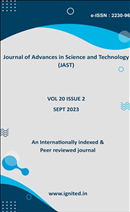An Analysis of Implementable Security Algorithms in the internet of things Envioronment
DOI:
https://doi.org/10.29070/a1f2r165Keywords:
Security, IoT, Envioronment, AlgorithmsAbstract
In the scientific community, the Internet of Things (IoT) is the latest buzzword. We live in an age where Internet access is not only possible for the vast majority of the population, but also increasingly affordable. The number of gadgets with internet access and built-in sensors continues to rise. Indeed, the prevalence and prevalence of smart phones, and the use of such devices, are on the rise. With this idea, anybody can hook up any device to the web. However, a major security issue will arise from the practise of storing and communicating data with anyone and any device. It's also unclear how well data can be transferred, communicated, and shared in this setting. In this paper, we discuss concerns about IoT security, including those of privacy, reliability, and accessibility. The rapidly evolving applications made possible by the IoT have drastically altered daily life, making it feel more fantastical and akin to living in a virtual world. Due to its open nature, the Internet of Things (IoT) might pose significant security challenges. A variety of methods, including encryption, are employed to protect the information transmitted by IoT devices.
Downloads
References
Charnes, C., & Pieprzyk, J. (2018). An algebraic analysis of Trivium ciphers based on the boolean satisfiability problem. In Proceedings of the 4th International Workshop on Boolean Functions: Cryptography and Applications, pp. 173-184.
Hao, Y., Bai, D., & Li, L. (2015). A meet-in-the-middle attack on roundreduced mCrypton using the differential enumeration technique. In International Conference on Network and System Security, pp. 166-183.
Biham, E., Anderson, R., & Knudsen, L. (1998). Serpent: A new block cipher proposal. In International workshop on fast software encryption, pp. 222-238.
Matsui, M., Moriai, S., Nakajima, J., & Tokita, T. (2000). Camellia: A 128-bit block cipher suitable for multiple platforms—design andanalysis. In International Workshop on Selected Areas in Cryptography, pp. 39-56.
Leander, G., Toz, D., Varici, K., & Verbauwhede, I. (2016). Spongent: The design space of lightweight cryptographic hashing. IEEE Transactions on Computers, 62(10), 2041-2053.
Dutta, I. K., Ghosh, B., & Bayoumi, M. (2019). Lightweight Cryptography for Internet of Insecure Things: A Survey. In 2019 IEEE 9th Annual Computing and Communication Workshop and Conference (CCWC), pp. 0475-0481.
Biryukov, A., Velichkov, V., & Le Corre, Y. (2016). Automatic search for the best trails in ARX: application to block cipher speck. In International Conference on Fast Software Encryption, Lect. Notes Comput. Sci. (including Subser. Lect. Notes Artif. Intell. Lect. Notes Bioinformatics), 9783(2008), 289- 310.
Hu, S., Philip, N. Y., & Sungoor, A. (2016). The potential of Internet of m-health Things “m-IoT” for non-invasive glucose level sensing. In 2011 Annual International Conference of the IEEE Engineering in Medicine and Biology Society, pp. 5264-5266. IEEE.
Al-Enezi, K. A., and Alenezi, A. Y. (2018). Improving the cost factor of dlbca lightweight block cipher algorithm. Indonesian Journal of Electrical Engineering and Computer Science 10, 2, 786–791.
Mohammadi, M. and Ayyash, M. (2015). Internet of things: A survey on enabling technologies, protocols, and applications. IEEE communications surveys & tutorials 17, 4, 2347–2376.
Weeks, B., and Wingers, L. (2015). The simon and speck lightweight block ciphers. In Proceedings of the 52nd Annual Design Automation Conference. 1–6.
Bhardwaj, I., Kumar, A., and Bansal, M. (2017). A review on lightweight cryptography algorithms for data security and authentication in iots. In 2017 4th International Conference on Signal Processing, Computing and Control (ISPCC). IEEE, 504–509.
Devalal, S. and Karthikeyan, A. (2018). Lora technology-an overview. In 2018 Second International Conference on Electronics, Communication and Aerospace Technology (ICECA). IEEE, 284–290.






